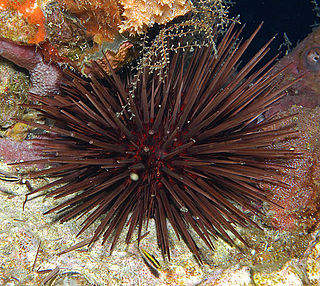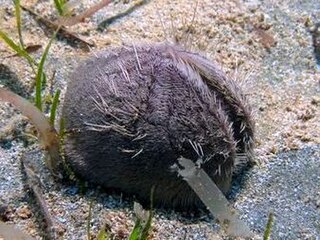
Diadema is a genus of sea urchins of the family Diadematidae.

Arbacia is a genus of sea urchins, widespread in the Atlantic and eastern Pacific oceans.

The Atlantic purple sea urchin is a species of sea urchins from the family Arbaciidae, native to the Atlantic Ocean.

The heart urchins or Spatangoida are an order of sea urchins.

The Echinacea are a superorder of sea urchins. They are distinguished by the presence of a rigid test, with ten buccal plates around the mouth, and solid spines. Unlike some other sea urchins, they also possess gills. The group is a large one, with species found worldwide.

Cidaroida, also known as pencil urchins, is an order of primitive sea urchins, the only living order of the subclass Perischoechinoidea. All other orders of this subclass, which were even more primitive than the living forms, became extinct during the Mesozoic.

Arbacia lixula, the black sea urchin, is a species of sea urchin from Europe.

Echinometra mathaei, the burrowing urchin, is a species of sea urchin in the family Echinometridae. It occurs in shallow waters in the Indo-Pacific region. The type locality is Mauritius.

The Camarodonta are an order of globular sea urchins in the class Echinoidea. The fossil record shows that camarodonts have been in existence since the Lower Cretaceous.

Echinometra is a genus of sea urchins in the family Echinometridae.

Arbacia dufresnii is a species of sea urchin of the family Arbaciidae. Its armour is covered with spines. A. dufresnii was first scientifically described in 1825 by Blainville.

Arbacia spatuligera is a species of sea urchin of the family Arbaciidae. Its armour is covered with spines. A. lixula was first scientifically described in 1846 by Valenciennes.

Arbaciella elegans is a species of sea urchin of the family Arbaciidae. Their armour is covered with spines. It is placed in the genus Arbacia and lives in the sea. Arbaciella elegans was first scientifically described in 1910 by Ole Theodor Jensen Mortensen.

Brissus unicolor is a species of sea urchins of the family Brissidae. Their armour is covered with spines. Brissus unicolor was first scientifically described in 1778 by Nathanael Gottfried Leske.

Diadema savignyi is a species of long-spined sea urchin belonging to the family Diadematidae. Common names include long-spined sea urchin, black longspine urchin and the banded diadem. It is native to the east coast of Africa, the Red Sea, the Indian Ocean and western Pacific Ocean. It was first described in 1829 by the French naturalist Jean Victoire Audouin. The specific epithet honours the French zoologist Marie Jules César Savigny who described many new marine species from the Mediterranean Sea and Red Sea. The type locality is Mauritius.

Scutellidae is a family of sand dollars in the superfamily Scutellidea. All genera except Scaphechinus are extinct.

The infraclassis Carinacea includes most living species of regular sea urchin, and fossil forms going back as far as the Triassic.

Athanas areteformis is a species of small alpheid shrimp from the Indo-West Pacific.

Parechinus angulosus, the Cape urchin, is a sea urchin in the family Parechinidae endemic to southern Africa. It is the only species in the genus Parechinus.



















